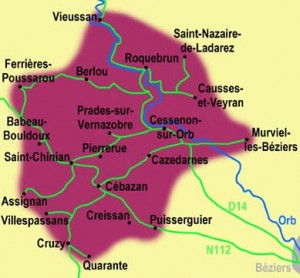 The Saint-Chinian appellation tends to be underestimated: on the one hand, because it is close (to the west) to the smaller but far better known Faugères appellation, and to the east it is overshadowed by the large Corbières growing area, which extends almost to the Spanish border. On the other hand - and this is probably decisive - the appellation is divided into two parts in terms of terroir: the northern part is dominated by slate soils (as in Faugères), while the southern part (closer to the sea) is dominated by clay and limestone soils, which naturally produces very different wines. In addition, the best wines (at least the best-known wines) probably come from the two sub-appellations Saint-Chinian Berlou and Saint-Chinian Roquebrun. A confusion that only connoisseurs of the Languedoc appellations can untangle.
The Saint-Chinian appellation tends to be underestimated: on the one hand, because it is close (to the west) to the smaller but far better known Faugères appellation, and to the east it is overshadowed by the large Corbières growing area, which extends almost to the Spanish border. On the other hand - and this is probably decisive - the appellation is divided into two parts in terms of terroir: the northern part is dominated by slate soils (as in Faugères), while the southern part (closer to the sea) is dominated by clay and limestone soils, which naturally produces very different wines. In addition, the best wines (at least the best-known wines) probably come from the two sub-appellations Saint-Chinian Berlou and Saint-Chinian Roquebrun. A confusion that only connoisseurs of the Languedoc appellations can untangle.
I didn't know the Cuvée Charlotte from the Domaine du Sacré Coeur until now. I got to know it yesterday, in my favourite local restaurant, on the recommendation of the landlady, whom I consider to have a good knowledge of wine. In any case, their wine list includes a few of the wineries from the region whose wines are among my "favourites" (and about which I have reported here several times).
I wanted to get to know something new that evening, something that doesn't necessarily belong to the circle of "the usual suspects". And so I came to Charlotte, the Cuvée from Saint-Chinian - quite open to new experiences, quite willing to leave the familiar behind and discover something new. What she offered was not new: the usual Languedoc assemblage of Grenache, Mourvèdre, Syrah and Carignan, which I am very familiar with (and which I also like so much!). But what struck me as different here, different from many (most?) Languedoc wines, is the power and variety of flavours, the uniqueness in the taste picture. It is not just one of the many good wines of the region, it is astonishingly independent, astonishingly full of character, accessible, despite a lot of tannins and acidity not at all a wild fellow, but also not a flatterer, like many of the Syrah-emphasised wines in the south of France are.
I think this is due to the dominance (or a considerable proportion) of Carignan, a grape variety that is increasingly being displaced by more pleasing ones or used too intensively for inconsequential mass wines, as they were made in the south of France for a long time. Here - it seems to me - one has renounced high yields (vendange en vert) or/and one could fall back on very old vines. In any case, one perceives the very special plum and even more the violet aromas, which are otherwise so often "washed away" in assemblages. For me, a great (not entirely new) experience.